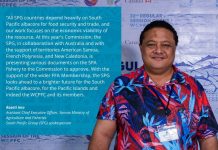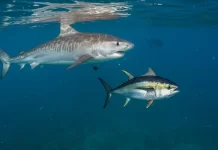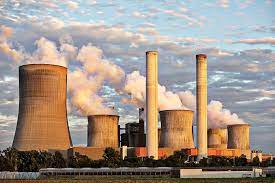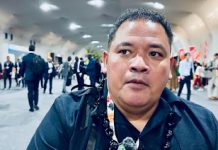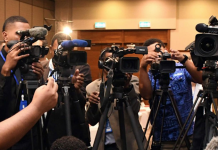By Isabelle Gerretsen
Talking about who is responsible for climate change is a fraught debate – even more so when it comes to who ought to pay for the damage it causes.
In September 2017, John Mussington was forced to evacuate his home and leave behind his animals when the small Caribbean island of Barbuda was hit by category 5 Hurricane Irma, at 185mph (300km/h).
“It was devastating,” says Mussington, a marine biologist and a high school principal on Barbuda. “People were traumatised, there were many buildings without roofs and we had no electricity. Our immediate concern was: how do we survive the next day?”
Every building was damaged by Irma, with 23% completely destroyed. A 2018 study concluded that climate change worsened destructive hurricanes, including Irma, by increasing rainfall by between five and 10 percent.
The initial shock was compounded when all of Barbuda’s 1,800 residents were ordered to evacuate to their sister island, Antigua, for one month. Mussington says this completely upended his life.
“That was the most traumatic of all, sitting there in Antigua, worrying about our farms, animals and businesses instead of starting the recovery,” he recalls. “I’m a beekeeper and all my colonies were knocked down – I lost my business, as did many farmers and fishermen.”
“When countries lose their islands because of sea level rise and extreme events, they are losing their culture and traditions. There is no adapting to that,” says Le-Anne Roper, coordinator for loss and damage at the Alliance of Small Island States (AOSIS).
For Barbudans, the destruction of the biodiversity and local environment is a direct violation of their way of life. “Our whole culture, identity and way of life is linked to the environment and natural resources,” says Mussington, adding that many Barbudans spend their spare time outdoors, fishing, hunting and camping in the wild. “It is part of who we are as Barbudans.”
Damaged buildings and job losses aren’t the only victims of extreme weather events caused by climate change. From Barbuda to Fiji, entire cultures are at stake. But with more awareness, new technologies and strong calls for international support, these small island nations are fighting back.
AOSIS, which carries out advocacy at global climate negotiations on behalf of 39 small island nations, first raised the issue of loss and damage in 1991, shortly after it was founded, when it called for support for islands facing rising sea levels. Rich nations have strongly resisted these calls, insisting that humanitarian aid is enough to deal with the issue.
For the next 30 years, low-lying small island states and other climate vulnerable countries have continued to ask rich nations to help them cope with extreme events, such as heatwaves, hurricanes and floods, as well as slow-moving climate threats, such as rising seas. They argue that rich countries should pay for the climate-induced losses and damages they are suffering because they are responsible for almost 80% of historical emissions.
At the United Nations’ global climate talks in Glasgow in November, developing countries fought hard for a dedicated loss and damage funding facility, a formal body set up under the United Nations Framework Convention on Climate Change to provide new financial support to affected nations. But the final Glasgow climate pact made no reference to climate finance to address the rising costs of losses and damages in developing countries. Instead, rich nations said they would establish “a dialogue” to discuss “arrangements for the funding of activities to avert, minimise and address loss and damage”
At the climate talks, Barbados’ Prime Minister Mia Mottley told world leaders that asking countries on the frontlines of the climate crisis, like small island states, to pay for climate damages is “like asking the passengers of a car crash to pay for damages, rather than the driver”.
“Failure to provide critical finance is measured in lives and livelihoods in our communities,” Mottley said, adding that she felt it was “Immoral” and “unjust”.
Vulnerable countries say they urgently need finance and technical support now as they already face deadly climate impacts, which will intensify as the planet gets hotter. According to the latest report by the UN Intergovernmental Panel on Climate Change (IPCC), “…every additional 0.5C of global warming causes clearly discernible increases in the intensity and frequency” of extreme events such as heatwaves, heavy rainfall and droughts.
“We can’t ignore [these impacts] anymore,” says Adelle Thomas, senior Caribbean research associate at Climate Analytics. “It’s happening now in developed countries [too],” she says, referring to the floods in Germany in July which killed more than 200 people and caused up to €5bn (£4.2bn/US$5.8 bn) in economic losses.
A study by Christian Aid highlights the devastating economic impact climate change will inflict on the world’s 65 most-vulnerable countries: if global temperatures were to rise by 2.9C, their average GDP will fall by 20% by 2050 and 64% by 2100. After the United Nations’ global climate talks in November, policies now put the world on a path towards 2.4C.
Preventative approach
Every year Fiji deals with extreme events, ranging from powerful cyclones to prolonged droughts, says Dr Satyendra Prasad, Fiji’s Ambassador to the United Nations. “One-tenth of our economy was wiped out by three events last year alone, when we were also fighting Covid-19. That is the difference between small and large states,” says Prasad.
In 2021, Fiji launched a parametric insurance scheme, in partnership with United Nations agencies, that offers immediate payouts to poor women and other vulnerable communities after a disaster. This targeted finance helps them rebuild their lives following a catastrophe, says Prasad.
The government is also relocating 20,000 people living in 45 coastal communities inland to protect them from rising sea levels, with funding raised by Fiji’s environment and climate adaptation tax. “It’s not only about moving homes,” says Prasad. 2We have to build new roads, move schools and provide electricity – all the things that make life possible.”
The constant pressure to rebuild after extreme events makes it almost impossible for Fiji to invest in education, healthcare and infrastructure. “We are spending more money repairing and rebuilding schools than on expanding education,” says Prasad, adding that money for healthcare is diverted to social services to help vulnerable communities recover.
Meanwhile in Pakistan, a pilot project launched by the Start Network, a coalition of 50 aid agencies and nonprofits, aims to take early intervention a step further. The network is trying to prevent extreme weather from leading to hunger and poverty by spotting the signs of risk early and acting fast.
Using satellite images and statistical modelling, the tool predicts when extreme events, such as droughts or floods, are about to hit and activates an alert for early intervention – providing both money and crucial technical expertise. This allows vulnerable communities to develop early response plans and minimise the impacts as much as possible. This model, which predicts a fall in crop yields, has allowed communities in Pakistan to switch to planting drought-resistant crops, preserve water and immunise their cattle up to one month ahead of a drought.
“It is a very effective, targeted and fast response, before a hazard has occurred on the ground,” says Amjad Ahmad, the network’s disaster risk financing coordinator in Pakistan.
The initial results are positive, says Ahmad. Fewer children have dropped out of school and families haven’t been forced to move to urban slums in search of work. Communities have also been able to access funding before droughts and other climate shocks hit.
“We don’t need to see suffering for the funding to be released,” says Sarah Klassen, Start Network’s policy and advocacy advisor. “We really see anticipatory action as one of the practical ways that humanitarians can address and minimise loss and damage caused by climate change,” says Klassen.
The liability problem
These kinds of interventions require technological expertise and, crucially, the money to finance them. But the big question is, who should foot the bill?
Rich nations, who typically have the largest historic emissions, are concerned that they could be held liable for the decades of pollution they have caused. When loss and damage was included in the Paris Agreement in 2015, the U.S pushed for a clause to be added which stated that the accord “does not involve or provide a basis for any liability or compensation”.
The liability and compensation debate has made loss and damage “a political taboo” and stalled negotiations, says Thomas.
Despite signing up to a “high ambition coalition” with small island states and vulnerable nations at the November climate talks in Glasgow, the U.S and EU blocked their proposal for a loss and damage funding facility. When asked why the US opposed establishing such a facility, Washington’s special climate envoy John Kerry told reporters: “We remain always thoughtful about the issue of liability and where this goes.”
Fijian Ambassador Prasad says the political negotiations need to move beyond this conundrum. “It should be about problem solving long-term, not about retribution and who is responsible for which share,” he says.
Providing loss and damage support isn’t purely altruistic, says Olivia Serdeczny, a research analyst at Climate Analytics, specialising in loss and damage. “At some point developed countries could act out of self-interest. They don’t want political systems in developing countries to become destabilised and to be faced with climate migrants,” she says.
How much is needed?
Campaigners say vulnerable nations need at least US$300bn (£225bn) a year to respond to loss and damage in 2030. Developing countries say this recovery finance should be in addition to money set aside for climate mitigation and adaptation, which falls under a global climate finance pledge.
“The volume and scale of resources [needed] is beyond what countries like ours can afford,” says Prasad. “We need dedicated, ring-fenced resources for loss and damage.”
At the UN climate talks in November, Scotland became the first country in the world to set aside specific funding for loss and damage, pledging £2m (US$2.7m) to help communities on the frontlines of the climate crisis. Although a small amount, the pledge was considered highly symbolic. But other countries resisted opening up a new channel of climate finance.
One area where progress was made at the talks was rich countries agreeing to fund the Santiago Network, a mechanism established in 2019 to provide technical assistance to countries experiencing loss and damage. The plan is to get this network up and running before the next United Nations climate meeting, which will be held in Egypt in November 2022.
“It is expected to provide demand-driven technical assistance and solutions to countries,” says Harjeet Singh, senior advisor to Climate Action Network International. “Such support will help generate knowledge and information for countries who need technical assistance in dealing with the increasing intensity and frequency of extreme weather events and new challenges like rising sea levels, melting of glaciers and oceans turning acidic.”
But vulnerable countries say the network alone does little to relieve the challenges they face. “[Climate disasters] are our lived reality,” says Prasad. “Every year that we are delaying action, we are increasing the scale of problems around loss and damage.”
“We are at a real tipping point,” says Thomas. “We are reaching our limit of waiting and fighting.”
After Hurricane Irma, loss and damage finance would have helped Barbuda rebuild faster and in a resilient way, so that the island can withstand future hurricanes, says marine biologist Mussington. The funds could be used to switch Barbuda’s main power supply to renewable energy, like wind power, which is not only more sustainable but can be adapted to better withstand storms and keep the lights on after a severe storm, he says.
International support would also allow for more investment in Barbuda’s mangroves, coral reefs and beaches – all core ingredients of cultural life in Barbuda – and which act as critical barriers for storm surges, he adds. “If we do not maintain these, we do not maintain our culture and identity,” he said.
SOURCE: BBC NEWS/PACNEWS



